Manufacturing LockoutTagout Manufacturing Industry Page 1 Manufacturing LockoutTagout




























































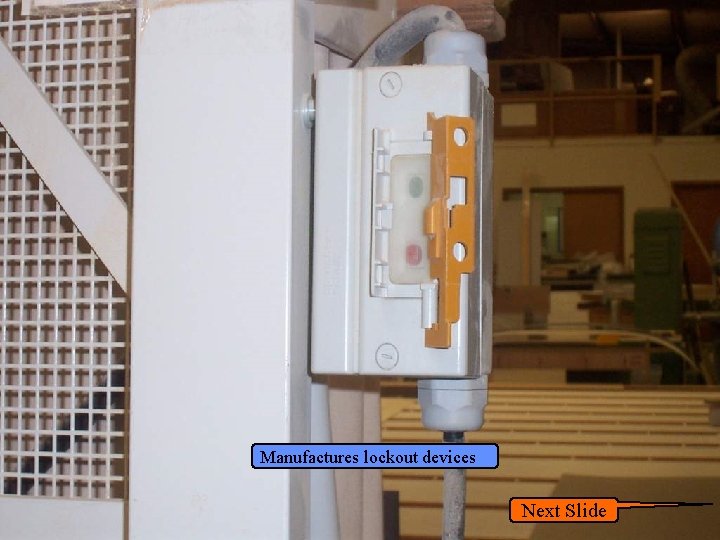

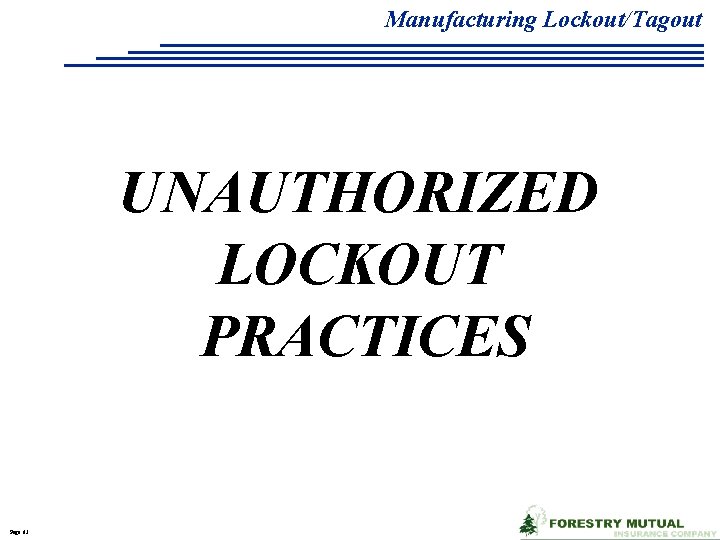
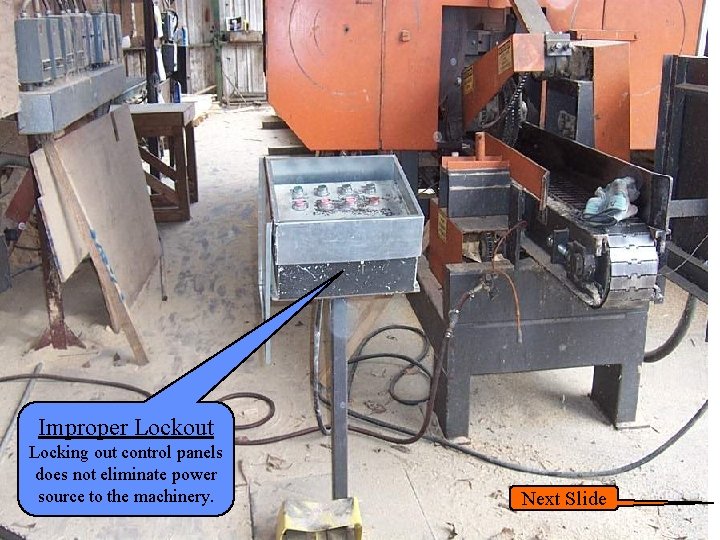
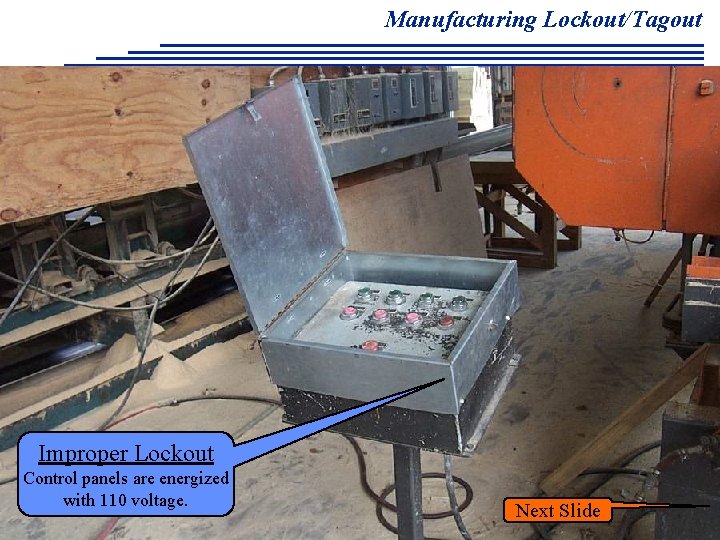
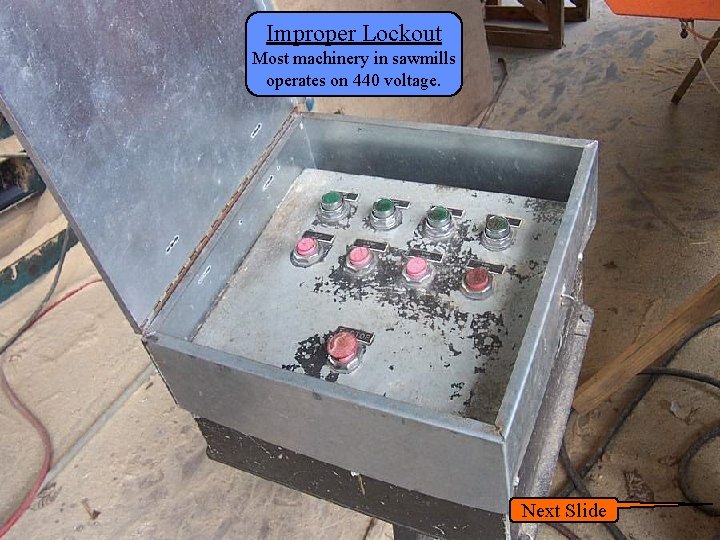
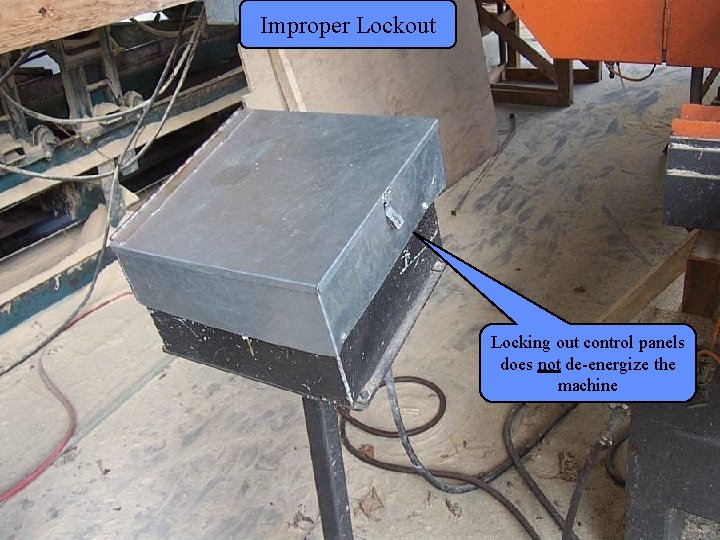
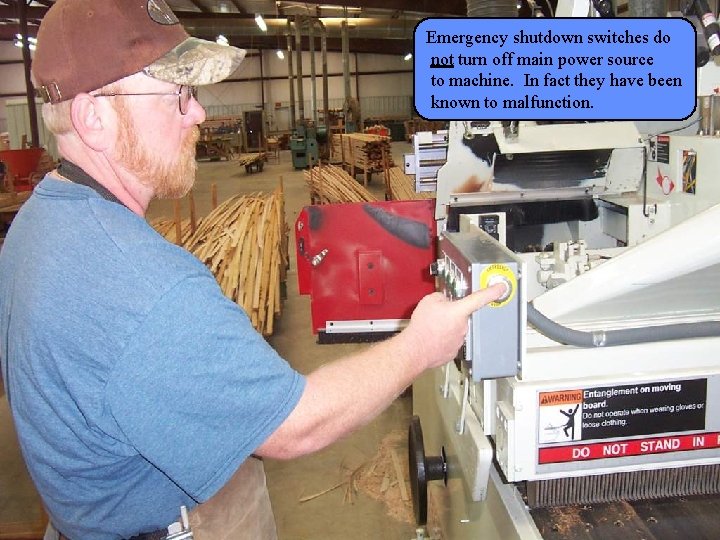
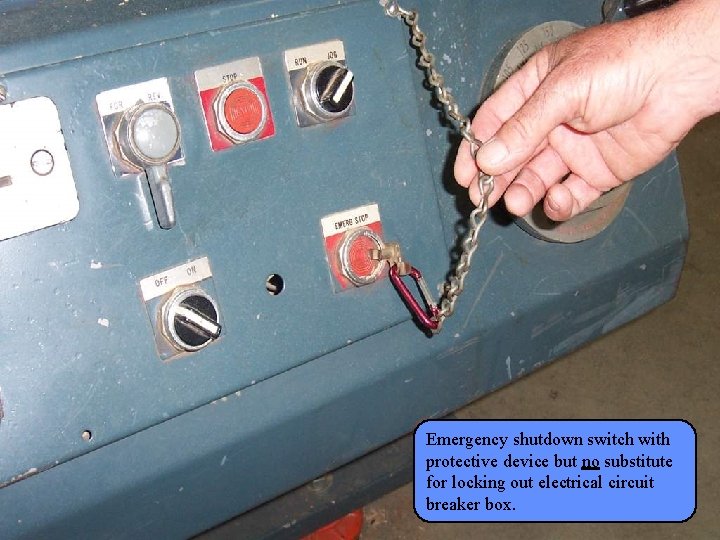
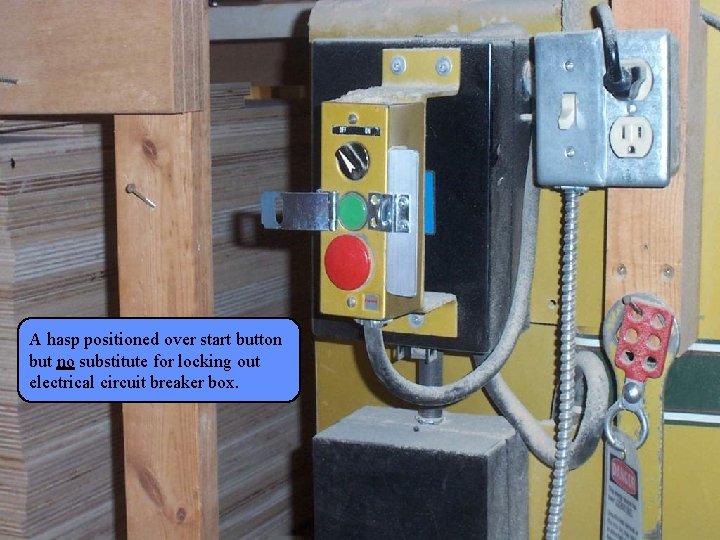
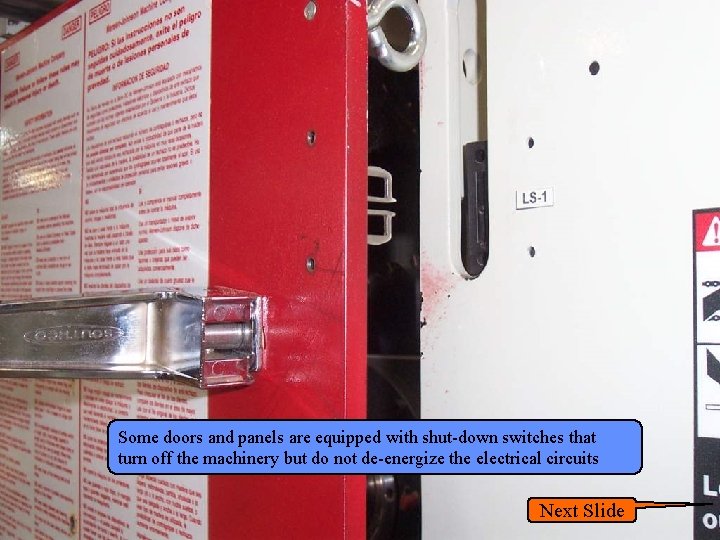
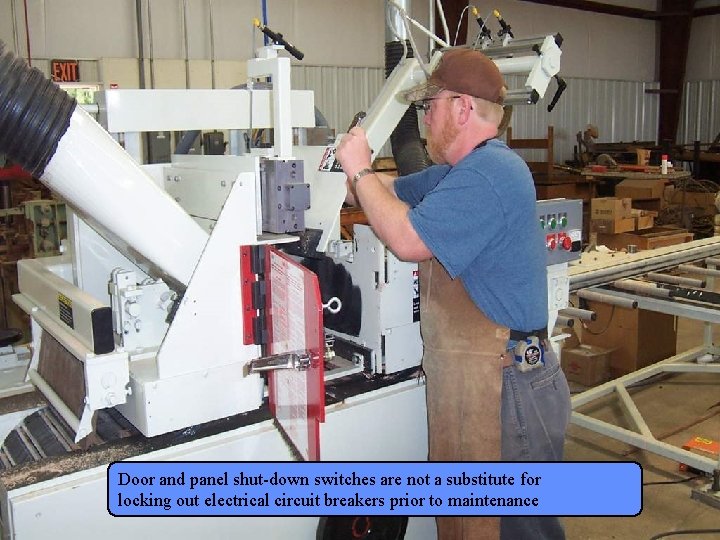
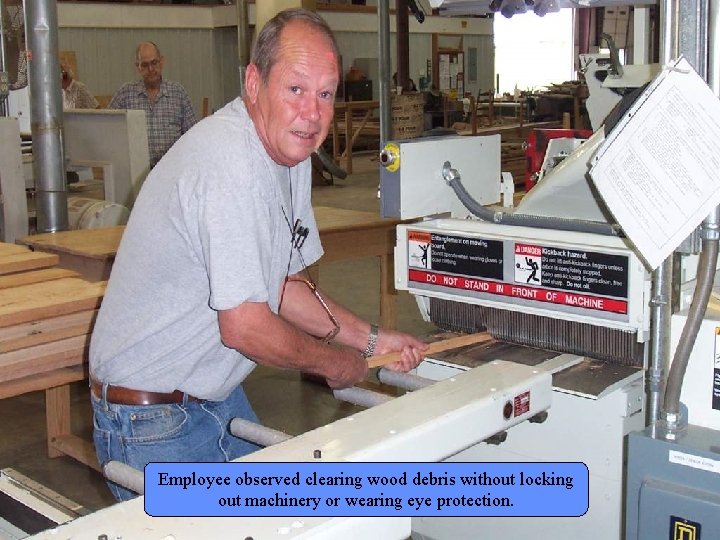
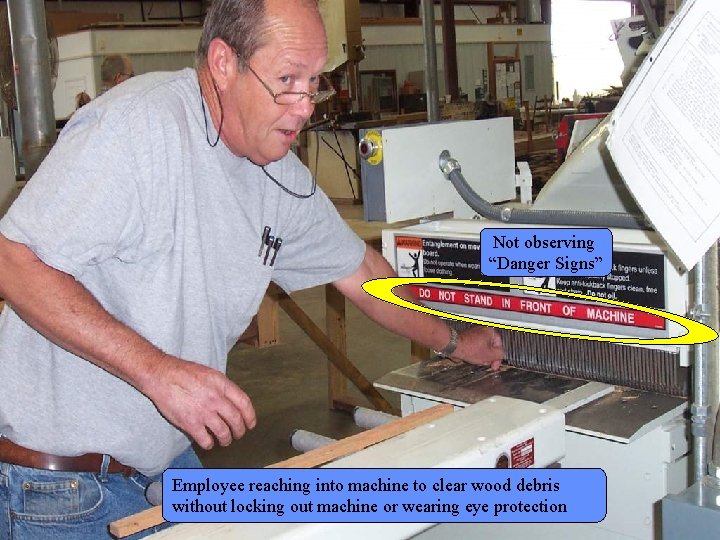
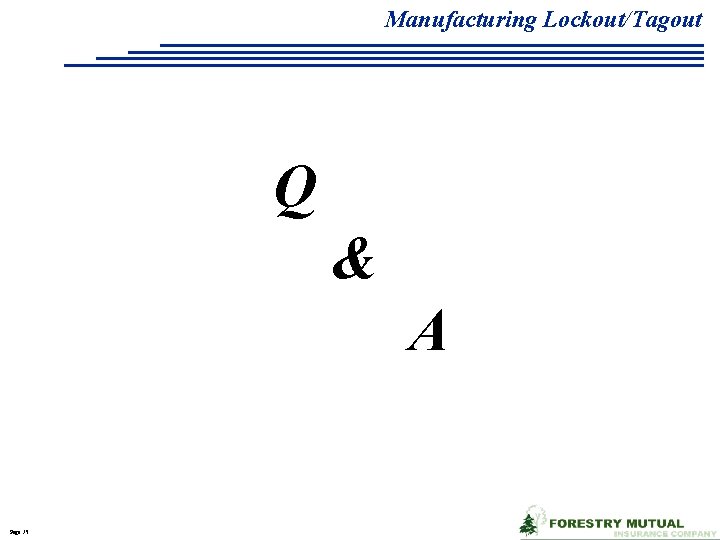

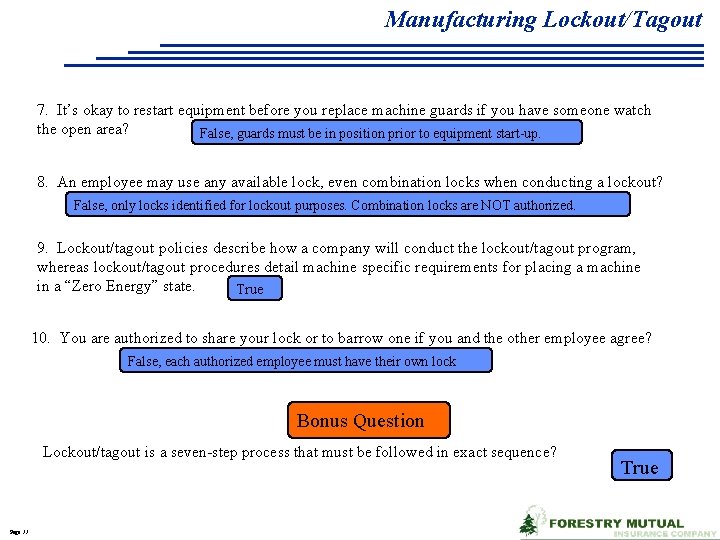
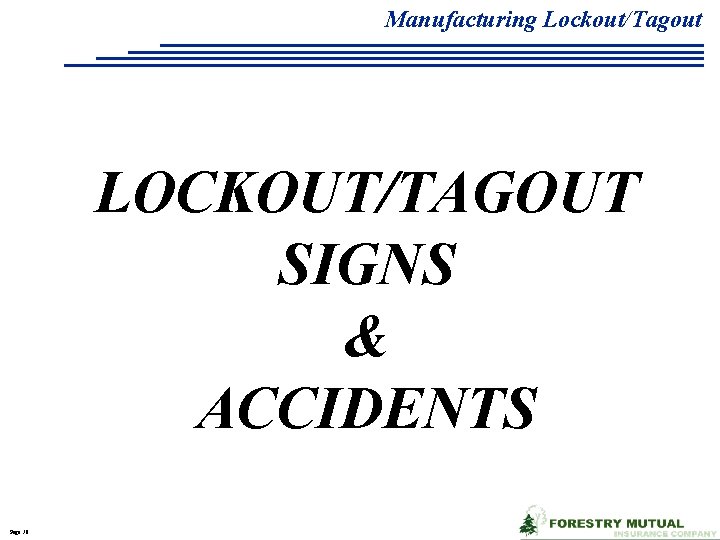
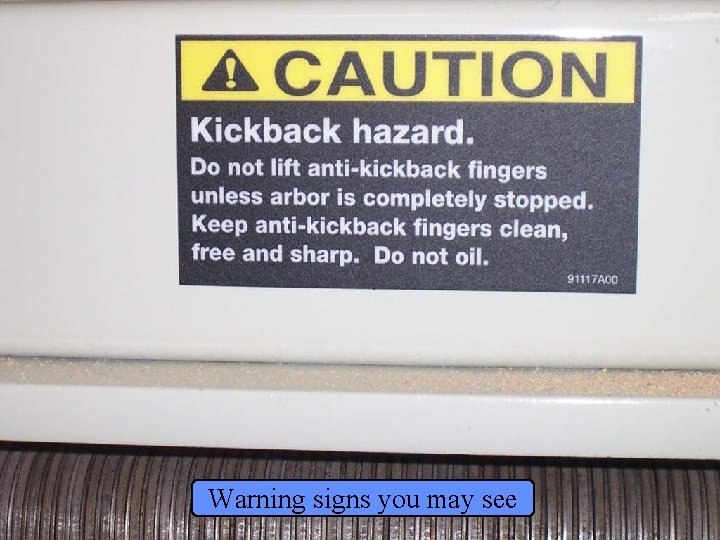
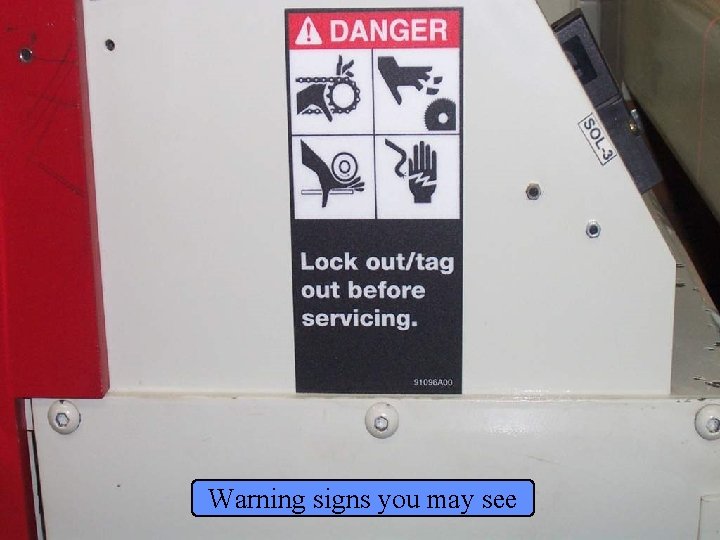
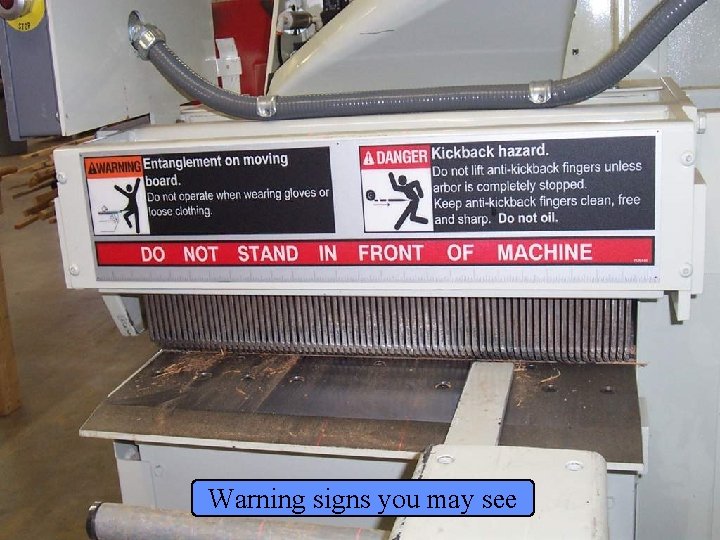
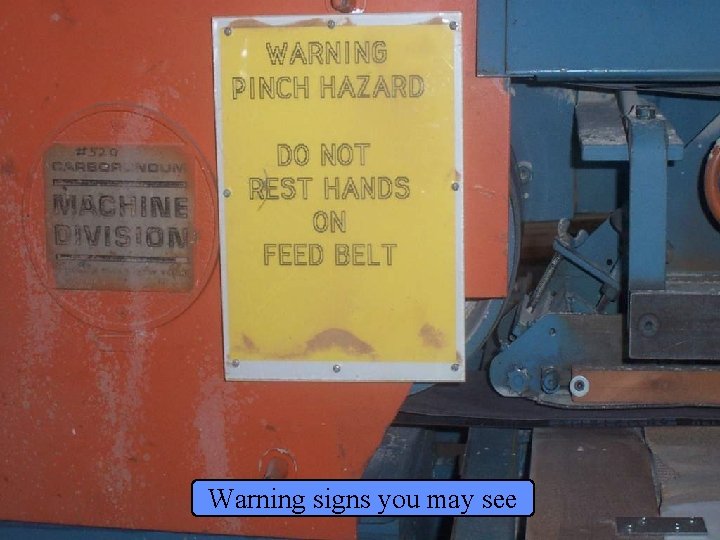
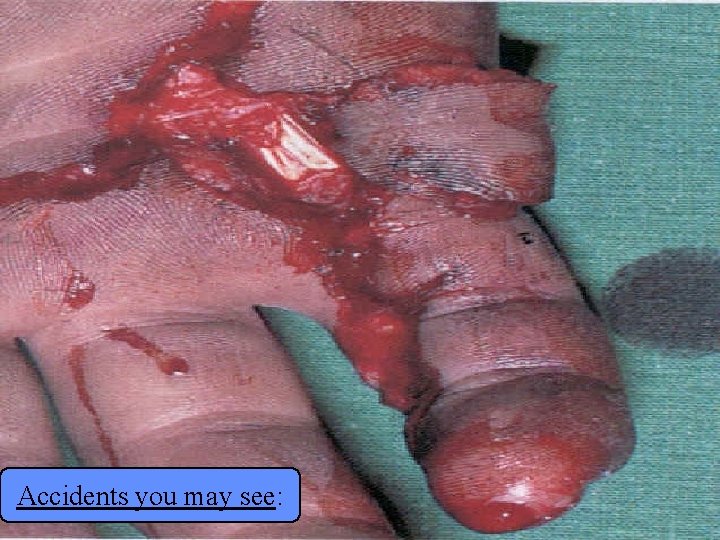
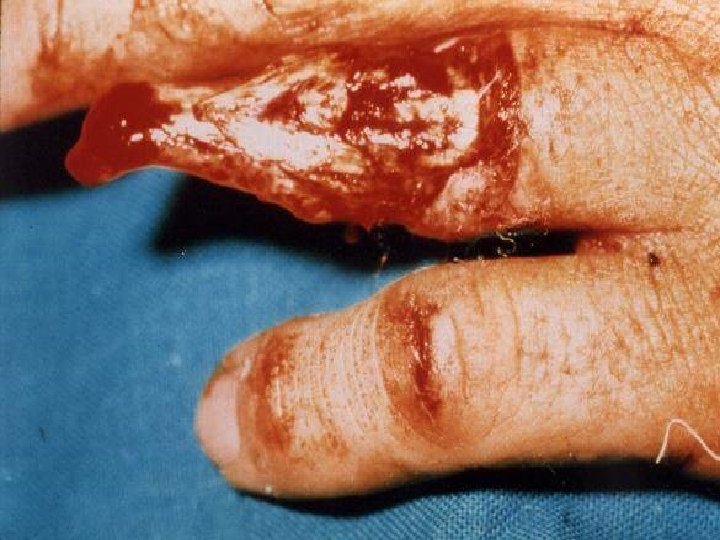

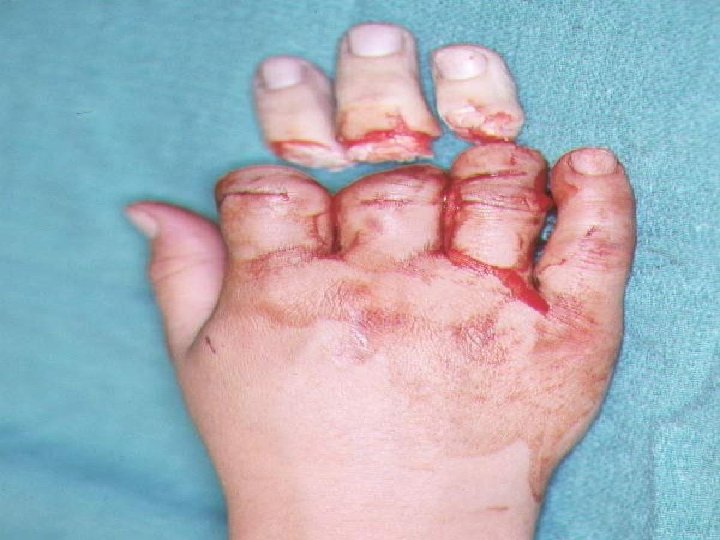
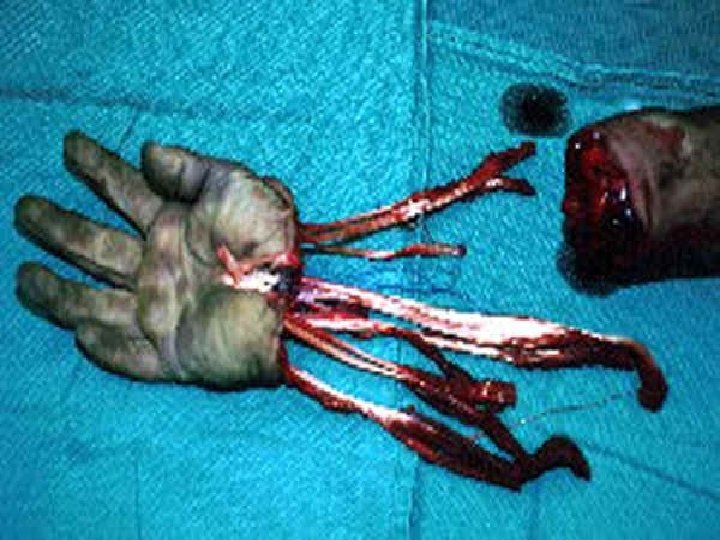
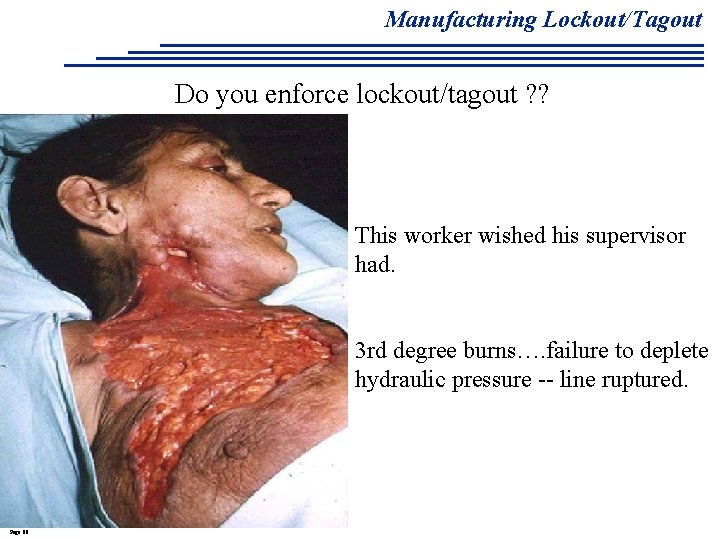
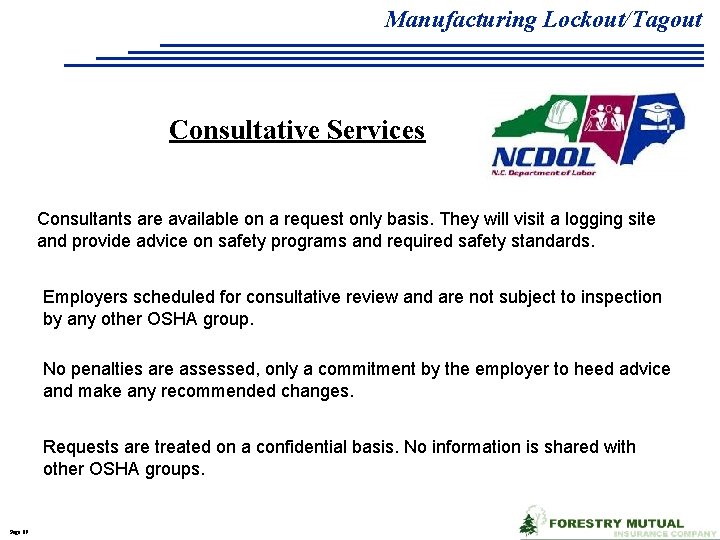
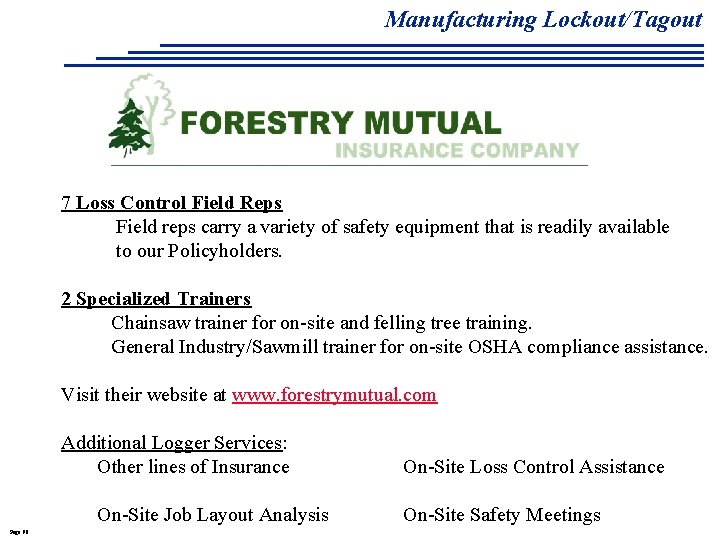
- Slides: 90

Manufacturing Lockout/Tagout Manufacturing Industry Page 1

Manufacturing Lockout/Tagout TOPICS OF DISCUSSION Legal Responsibilities Management / Supervisory responsibilities LOTO Personnel LOTO Energy Source(s) LOTO Procedures Page 2

Lockout/Tagout Lockout/ Tagout. Manufacturing Process Lock and tag is a two part process. The lock disables and the tag is a warning. Page 3

Manufacturing Lockout/Tagout MANAGEMENT & SUPERVISORY RESPONSIBILITIES Page 4

Manufacturing Lockout/Tagout Legal Responsibilities u u u Page 5 Ethical and moral duty, you have a legal responsibility for safety as a supervisor. Federal law; supervisors can be held criminally liable for serious injury or death of an employee if proved negligent in their duties. Fines/prison time for serious and/or willful violations.

Manufacturing Lockout/Tagout Fine and Jail Sentence for Worker Electrocution Company fined $140, 000 Supervisor sentenced to a year in jail Company had received notification and several warnings that no work was to be accomplished until a power line crossing the job site was de-energized (locked-out and tagged-out). Supervisor knowing the hazard, directed an employee to drive a dump truck into the hazard area. Then provided instructions to the employee to raise the truck bed under the energized power line. The employee was severely burned and died on the scene. Information Source: Safety 21 OSHA-Compliant Workplace - October 2003 Page 6

Manufacturing Lockout/Tagout Management Responsibilities u u u Page 7 Develop company policy for implementing lockout/tagout procedures for the control of hazard energy during maintenance operations. Establish written machine-specific procedures to include applying the locks and tags, release, and notification from lockout. Train authorized and affected employees on proper use of procedures.

Manufacturing Lockout/Tagout Supervisors Responsibilities u Ensure initial LOTO training. u Monitor refresher training. u u u Page 8 Check for shortcuts, mistakes, or unsafe work practices. Ensure retraining if job assignments change, new machines, control procedures or modifications occurs. Enforcement of machine-specific procedures to include applying the locks and tags, release, and notification from lockout.

Manufacturing Lockout/Tagout LOTO PERSONNEL Page 9

Manufacturing Lockout/Tagout Your Role You are either an Affected Employee An Authorized Employee Or Both ! Page 10

Affected Employee An individual that operates the machinery but does not perform the lockout procedures Pertains to any employee whose job require them to work in an area where maintenance is performed Page 11 Manufacturing Lockout/Tagout

Manufacturing Lockout/Tagout Affected Employee Responsibilities Stay clear of the area as much as possible. Watch out for others in the area. Never attempt to assist if your not properly trained. Never interfere or tamper with a lock or tag. Report all unusual situation to your supervisor or foreman. Page 12

Manufacturing Lockout/Tagout Authorized Employee An individual who has been properly trained to use lockout/tagout procedures on a machinery or equipment that is to be serviced. Page 13

Manufacturing Lockout/Tagout Authorized Employee Responsibilities Verify the isolation. Properly plan the job. Notify all affected employees in the area of work. Shut down the equipment at the operating controls. Isolate all energy sources to equipment. Lock and tag all isolating devices. Dissipate all stored or residual energy sources. Page 14

Manufacturing Lockout/Tagout Could be Both An authorized employee and an affected employee may be the same person, when the affected employees’ duties also include performing maintenance or service on a machine or equipment that requires lockout tagout procedure. Page 15

Manufacturing Lockout/Tagout LOTO ENERGY SOURCES Page 16

Manufacturing Lockout/Tagout Types of Energy Thermal Electrical Mechanical Chemical Air Pneumatic Hydraulic Could be more depending on machinery type ! Page 17

Manufacturing Lockout/Tagout Electrical Energy Hazards Can cause shock and/or fire Page 18

Manufacturing Lockout/Tagout Hydraulic Energy Hazards Energy of liquids under pressure - Pressure can cause parts to move - Rapid release can cause injury - Hydraulic fluid can burn you Page 19

Manufacturing Lockout/Tagout Next Slide Hydraulic values must also be locked out Page 20

Manufacturing Lockout/Tagout Holes drilled in handles to lockout with a chain. Page 21

Manufacturing Lockout/Tagout Thermal Energy Hazards Energy of Heat /Cold Boiler Hot equipment & fluids will burn you Page 22 Cold fluids can cause severe injury

Pneumatic Energy Hazards Manufacturing Lockout/Tagout Energy of compressed gases Uncontrolled release can cause injury Properly vent all systems before starting maintenance Page 23

Manufacturing Lockout/Tagout Six-point hasp used to lockout air valve Page 24

Manufacturing Lockout/Tagout Pneumatic energy can be very dangerous Page 25

Manufacturing Chemical Energy Hazards Lockout/Tagout Machinery that use any chemicals have energy that can start fires, cause skin burns and generate harmful gases or fumes Lubricants, Hydraulic fluid, Fuels, Coolants, Solvents Page 26

Manufacturing Lockout/Tagout Mechanical Energy Hazards Two Types 1. Parts that are still in motion 2. Parts that store energy sources Page 27

Manufacturing Lockout/Tagout Mechanical Energy Hazard Parts that are still in motion A chipper or hog can remain in motion long after power is locked out Page 28

Manufacturing Lockout/Tagout Mechanical Energy Hazard Parts that store energy sources Position blocks to prevent parts from Falling or moving A plywood press has stored energy by the hydraulic actuators it uses Page 29

Manufacturing Lockout/Tagout LOTO PROCEDURES Page 30

Manufacturing Lockout/Tagout Program The purpose of lockout/tagout is to prevent energy sources from accidentally being released while a machine or equipment is being serviced. The ultimate goal of lockout/tagout is to protect the safety and health of employees. “Over 70% of all accidents come from improperly applied procedures or non-compliance” Page 31

Manufacturing Lockout/Tagout A H OS Page 32 OSHA requires employers to develop, document, and implement machine specific procedures for the control of hazard energy source(s) during maintenance operations.

Manufacturing Lockout/Tagout LOCKOUT /TAGOUT PROCEDURE MACHINE NAME AND NUMBER ENERGY SOURCE(S) ELECTRICAL CHEMICAL GRAVITY HYDRAULIC MECHANICAL PNEUMATIC THERMAL OTHER: LOCKOUT/TAGOUT PROCEDURE ELECTRIC: PNEUMATIC: HYDRAULIC: RESTORING TO NORMAL OPERATIONS ADDITIONAL SAFETY FEATURES Page 33

Manufacturing Lockout/Tagout Machinery Lockout/Tagout 7 -step process 1. Prepare for shutdown 2. Shut down equipment 3. Isolate all energy sources 4. Install Locks and Tags 5. Verify stored energy shutdown 6. Verify equipment isolation 7. Release from Lockout Page 34

Step 1 Prepare for shutdown Manufacturing Lockout/Tagout Must know what energy sources associated with equipment Electrical Hydraulic Pneumatic Thermal Mechanical Chemical Page 35

Step 2 Manufacturing Lockout/Tagout Shut down equipment Use normal shutdown procedure Page 36

Step 3 Isolate all energy sources Manufacturing Lockout/Tagout Turn off power at machinery Page 37

Manufacturing Lockout/Tagout Turn off power at machinery at electrical circuit breaker boxes Page 38

Manufacturing Lockout/Tagout Turn off Air and Hydraulic pressure Page 39

Manufacturing Lockout/Tagout Step 4 Install Locks and Tags Page 40

Manufacturing Lockout/Tagout Remember to put the key in your pocket – never leave it in the lock Page 41

Step 5 Verify stored energy is shut-down Ensure saw blades have come to a complete stop before removing guards Page 42 Manufacturing Lockout/Tagout

Manufacturing Lockout/Tagout Ensure cutter heads are not in motion Page 43

Step 6 Verify equipment isolation Manufacturing Lockout/Tagout Try to restart machinery following normal procedures Page 44

Manufacturing Lockout/Tagout Machinery is now safe for maintenance operations Page 45

Step 7 Release from Lockout Inspect Area and Equipment Reinstall machine guards Account for tools and parts Inform others of equipment start-up Page 46 Manufacturing Lockout/Tagout

Manufacturing Lockout/Tagout Additional lockout/tagout requirements: Conduct annual audits to validate effectiveness of the lockout/tagout procedures Review procedures annually or when required, especially after an accident has occurred. Maintain an equipment survey that list the equipment required to have lockout/tagout procedures, type(s) of energy sources, and magnitude of energy. Page 47 *

Manufacturing Lockout/Tagout MACHINERY LOCKOUT PRACTICES Page 48

Manufacturing Lockout/Tagout Lockout Program Awareness Posters Page 49

Manufacturing Lockout/Tagout Many employers now post their lockout procedures Page 50

Manufacturing Lockout/Tagout Unique Idea Color coded breaker boxes with drawings to the machines they controls Page 51

Manufacturing Lockout/Tagout Unique Idea Color coded breaker box with drawings Page 52

Manufacturing Lockout/Tagout Wooden box used to control electrical hazard for machine plug Page 53

Manufacturing Lockout/Tagout Single-point breaker clip used on multiple circuit breaker box Next Slide Page 54

Manufacturing Lockout/Tagout Single-point breaker clip Next Slide Page 55

Manufacturing Lockout/Tagout Single Point Breaker Clip Page 56

Manufacturing Lockout/Tagout Cables used to control electrical hazard for multiple electrical circuit breaker boxes Page 57

Manufacturing Lockout/Tagout Hinged brackets used to control electrical hazard for multiple electrical circuit breaker boxes Page 58

Manufacturing Lockout/Tagout Holes drilled in handles to lockout with a chain. Page 59

Manufacturing Lockout/Tagout Some manufactures install lockout devices on their equipment but you must ensure the device completely de-energizes the machine. Page 60 Next Slide

Manufacturing Lockout/Tagout Manufactures lockout devices Next Slide Page 61

Manufacturing Lockout/Tagout Must ensure that manufacture locking devices are in compliance with OSHA requirements Page 62

Manufacturing Lockout/Tagout UNAUTHORIZED LOCKOUT PRACTICES Page 63

Manufacturing Lockout/Tagout Improper Lockout Locking out control panels does not eliminate power source to the machinery. Page 64 Next Slide

Manufacturing Lockout/Tagout Improper Lockout Control panels are energized with 110 voltage. Page 65 Next Slide

Manufacturing Lockout/Tagout Improper Lockout Most machinery in sawmills operates on 440 voltage. Next Slide Page 66

Manufacturing Lockout/Tagout Improper Lockout Locking out control panels does not de-energize the machine Page 67

Manufacturing Lockout/Tagout Emergency shutdown switches do not turn off main power source to machine. In fact they have been known to malfunction. Page 68

Manufacturing Lockout/Tagout Emergency shutdown switch with protective device but no substitute for locking out electrical circuit breaker box. Page 69

Manufacturing Lockout/Tagout A hasp positioned over start button but no substitute for locking out electrical circuit breaker box. Page 70

Manufacturing Lockout/Tagout Some doors and panels are equipped with shut-down switches that turn off the machinery but do not de-energize the electrical circuits Next Slide Page 71

Manufacturing Lockout/Tagout Door and panel shut-down switches are not a substitute for locking out electrical circuit breakers prior to maintenance Page 72

Manufacturing Lockout/Tagout Employee observed clearing wood debris without locking out machinery or wearing eye protection. Page 73

Manufacturing Lockout/Tagout Not observing “Danger Signs” Employee reaching into machine to clear wood debris without locking out machine or wearing eye protection Page 74

Manufacturing Lockout/Tagout Q & A Page 75

Manufacturing Lockout/Tagout 1. Employers are responsible for establishing a program consisting of energy control procedures, employee training and an annual inspection of the procedures? True 2. Employers have the option of using either lockout or tagout to control hazard energy sources during maintenance operations? False, lockout devices must be used. 3. Electrical circuit breaker boxes must be labeled as to which machinery item they control to enable emergency shut down of equipment if necessary? True 4. Every form of energy must be isolated and controlled by lockout/tagout and the lockout verified before beginning work? True 5. Lockout/tagout training is only required if the employer feels that the employee may be accident prone or after the employee is involved in an accident that is the result of improper lockout/tagout? False, initial training, new equipment, and if there has been a change to a procedure 6. The employer must develop and document a company lockout/tagout enforcement policy? True Page 76

Manufacturing Lockout/Tagout 7. It’s okay to restart equipment before you replace machine guards if you have someone watch the open area? False, guards must be in position prior to equipment start-up. 8. An employee may use any available lock, even combination locks when conducting a lockout? False, only locks identified for lockout purposes. Combination locks are NOT authorized. 9. Lockout/tagout policies describe how a company will conduct the lockout/tagout program, whereas lockout/tagout procedures detail machine specific requirements for placing a machine in a “Zero Energy” state. True 10. You are authorized to share your lock or to barrow one if you and the other employee agree? False, each authorized employee must have their own lock Bonus Question Lockout/tagout is a seven-step process that must be followed in exact sequence? Page 77 True

Manufacturing Lockout/Tagout LOCKOUT/TAGOUT SIGNS & ACCIDENTS Page 78

Manufacturing Lockout/Tagout Warning signs you may see Page 79

Manufacturing Lockout/Tagout Warning signs you may see Page 80

Manufacturing Lockout/Tagout Warning signs you may see Page 81

Manufacturing Lockout/Tagout Warning signs you may see Page 82

Manufacturing Lockout/Tagout Accidents you may see: Page 83

Manufacturing Lockout/Tagout Page 84

Manufacturing Lockout/Tagout Page 85

Manufacturing Lockout/Tagout Page 86

Manufacturing Lockout/Tagout Page 87

Manufacturing Lockout/Tagout Do you enforce lockout/tagout ? ? This worker wished his supervisor had. 3 rd degree burns…. failure to deplete hydraulic pressure -- line ruptured. Page 88

Manufacturing Lockout/Tagout Consultative Services Consultants are available on a request only basis. They will visit a logging site and provide advice on safety programs and required safety standards. Employers scheduled for consultative review and are not subject to inspection by any other OSHA group. No penalties are assessed, only a commitment by the employer to heed advice and make any recommended changes. Requests are treated on a confidential basis. No information is shared with other OSHA groups. Page 89

Manufacturing Lockout/Tagout 7 Loss Control Field Reps Field reps carry a variety of safety equipment that is readily available to our Policyholders. 2 Specialized Trainers Chainsaw trainer for on-site and felling tree training. General Industry/Sawmill trainer for on-site OSHA compliance assistance. Visit their website at www. forestrymutual. com Additional Logger Services: Other lines of Insurance On-Site Job Layout Analysis Page 90 On-Site Loss Control Assistance On-Site Safety Meetings